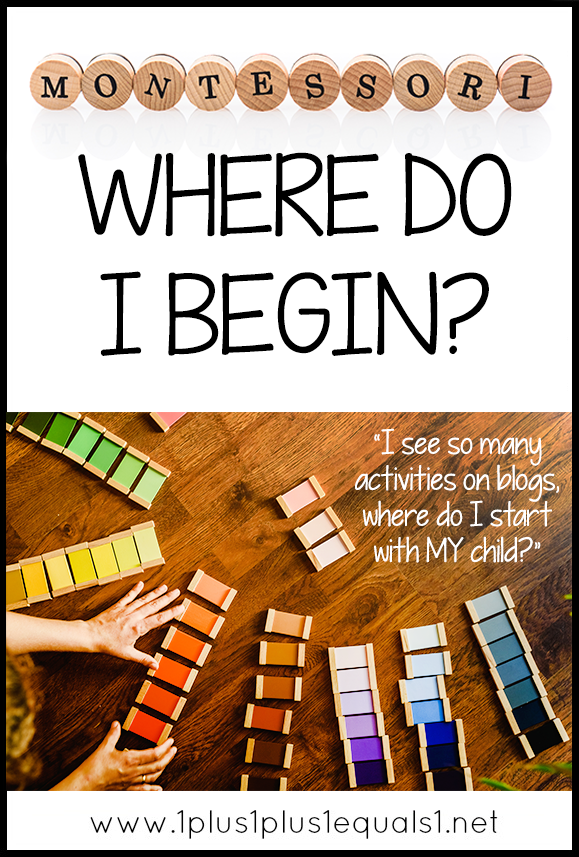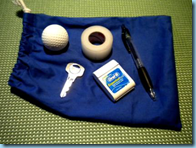
 Welcome back to Montessori Minute! These posts are written to support and encourage parents who are doing (or want to do) early learning activities at home in a Montessori way.
Welcome back to Montessori Minute! These posts are written to support and encourage parents who are doing (or want to do) early learning activities at home in a Montessori way.
One question I get from parents quite often is:
“I see so many activities on the blogs,
where do I start with MY child?”
Fantastic question! It goes to the heart of Montessori, and early learning in general. There is a lot to learn, and the variety of activities can be totally confusing for parents. This post will give you some ideas to help you simplify, organize, and get started!
To keep this post a reasonable length, I’m going to assume you are familiar with Maria Montessori and the basics of doing Montessori activities. Read the Montessori Minute post: Understanding Maria Montessori. There are many good resources, including:
-
- Montessori Education for the Early Years (video)
- Montessori in Your Home from the Parenting Squad
- American Montessori Society Nice summary from AMS
- Montessori Print Shop Check out the links to theory and activity areas
As you surf and read, keep these Montessori basics with special relevance to the home environment in mind:
-
- Independent activity & repetition
- Attractive, interesting, self-contained activities using three dimensional objects, displayed on low shelves
- Following the child’s lead
- Organization, respect for the materials, cleaning up
Ok, you’ve got your bearings and are ready to take that first step. I recommend that you:
Start with a Practical Life or Sensory activity
Practical Life and Sensory activities are the foundation of Montessori for 2-6 year olds. These activities are the reason children in Montessori schools have an easy time learning math and reading! Among a whole host of benefits, these activities:
-
- Open millions of brain nerve pathways and build strong brain architecture
- Give children a series of successes that build a confident self-image
- Help children learn to focus their concentration
- Support and encourage a young child’s strong drive toward independence
- Sharpen a child’s sensory acuity and discrimination
- Develop visual, muscle (motor), and abstract thinking skills
- Help children become life participants instead of spectators
Here are some good resources on these two types of Montessori activities:
Practical Life
-
- Informative article from Montessori Print Shop
- AMI quick guide to Practical Life activities
- Practical Life Curriculum Demonstrations (video)
- Living Montessori Now has a great page of info and links
Age-based suggestions for first Practical Life activities:
2-3 Years
Left: Pouring beans with plain cups. Middle: Sponging water. Right: The Rice Tub. Measuring spoons, cups, etc., in a plastic tub with rice for free exploration.
3-4 Years
Left: cutting a banana with a plastic knife. Middle: Nuts & Bolts. Right: Tongs and plastic golf balls transfer using a plastic egg carton.
4-5 Years
Left: Button sewing. Middle: Transferring pomp poms with tweezers. Right: Shoe tying.
Sensorial Activities
-
- Montessori Sensorial Curriculum Demonstrations (video)
- ** Don’t worry – you can make many materials can be made easily & inexpensively!
- Montessori Minute: Sensory Activities
- Introduction to Sensorial
Age-based suggestions for first Sensory Activities:
2-3 Years
Left: A sensory bin. Middle: the Pink Tower ready to build. Right: The Mystery Bag with a few very different shaped common objects.
3-4 Years
Left: Montessori Binomial Cube. Middle: Matching Color Cards. Right: Pasta Sorting.
4-5 Years
Left: Montessori Trinomial Cube. Middle: Color Mixing. Right: Montessori Blue Constructive Triangles.
-
- Pick an activity. Try an Everyday Life or Sensory activity.
- Decide on a place where the activity will be displayed. It may be a set of low shelves set up in your child’s room; or space you create on other open, low shelves your child can easily reach. If you don’t have a space, start anyway!
- Follow the activity directions. Involve your child in gathering materials and putting the activity together in its own nice container or on a nice tray. If you go shopping, take your child. If possible make a label, for example: Julie’s Nuts & Bolts, and tape it to the container.
- Start the Activity Cycle by having your child lay out a table mat or floor rug to make a work space; and carry the activity to it.
- Demonstrate the activity slowly for your child.
- Let your child work with the activity as long as he likes. Assist as needed, but as little as possible.
- When your child is done, make sure she puts everything back into the container and puts on the lid, if it has one.
- Your child carries the material to the shelf you have chosen. Let your child help decide where to put it and then set it there. Say, “This is where we will keep this activity.”
- Have your child put the rug or mat away where you two have chosen to store these items.
- Follow these steps with each new activity. You will build up a selection of learning materials, customized to your child’s current skill levels and interests, each with its own place on the shelf. Your child will know where each one goes and how the process of using the activities works.
Soon you will have a home Montessori school.
People will be asking you how you did it!
As you continue doing activities, these simple guidelines can help:
 The beauty of Montessori is that it follows the child. Trust the Inner Teacher inside your child and keep trying activities. Involve your child in looking for new ones on blogs and in books. Don’t expect a big success every day, things don’t go perfectly in Montessori schools either – have fun!
The beauty of Montessori is that it follows the child. Trust the Inner Teacher inside your child and keep trying activities. Involve your child in looking for new ones on blogs and in books. Don’t expect a big success every day, things don’t go perfectly in Montessori schools either – have fun!
Kitchens rock for doing Montessori!
Still think Montessori has to be complicated? Watch this video of a child helping his Mom boil potatoes. This may look like a simple Practical Life activity to pass the time. Not from the child’s perspective! This child is getting experiences with muscle skill practice, textures, water splashing, light refraction, sequencing, groups of objects changing in number, cooking, and look at his concentration and repetition! He is also having wonderful interactions with his Mom. Children get so much from this kind of activity, and it doesn’t require anything more than your involvement, time, and love!
John Bowman is the author of Help Your Preschooler Build a Better Brain.
© 2011 John Bowman
My thanks to John for writing this extensive article for us here at 1+1+1=1!
Did you miss earlier Montessori Minute Posts?
-
- Introducing Montessori Minute
- Sensory Activities
- Understanding Dr. Maria Montessori
- A Preschoolers Guide to Home Improvement
- Q & A with John Bowman {answers to questions left on the Sensory Activities post}
























[…] have access to all of it. After following lot of her ideas, I read her Montessori posts and I read this one in particular titled Montessori Minute ~ Where Do I Start?, which was my introduction to Montessori […]